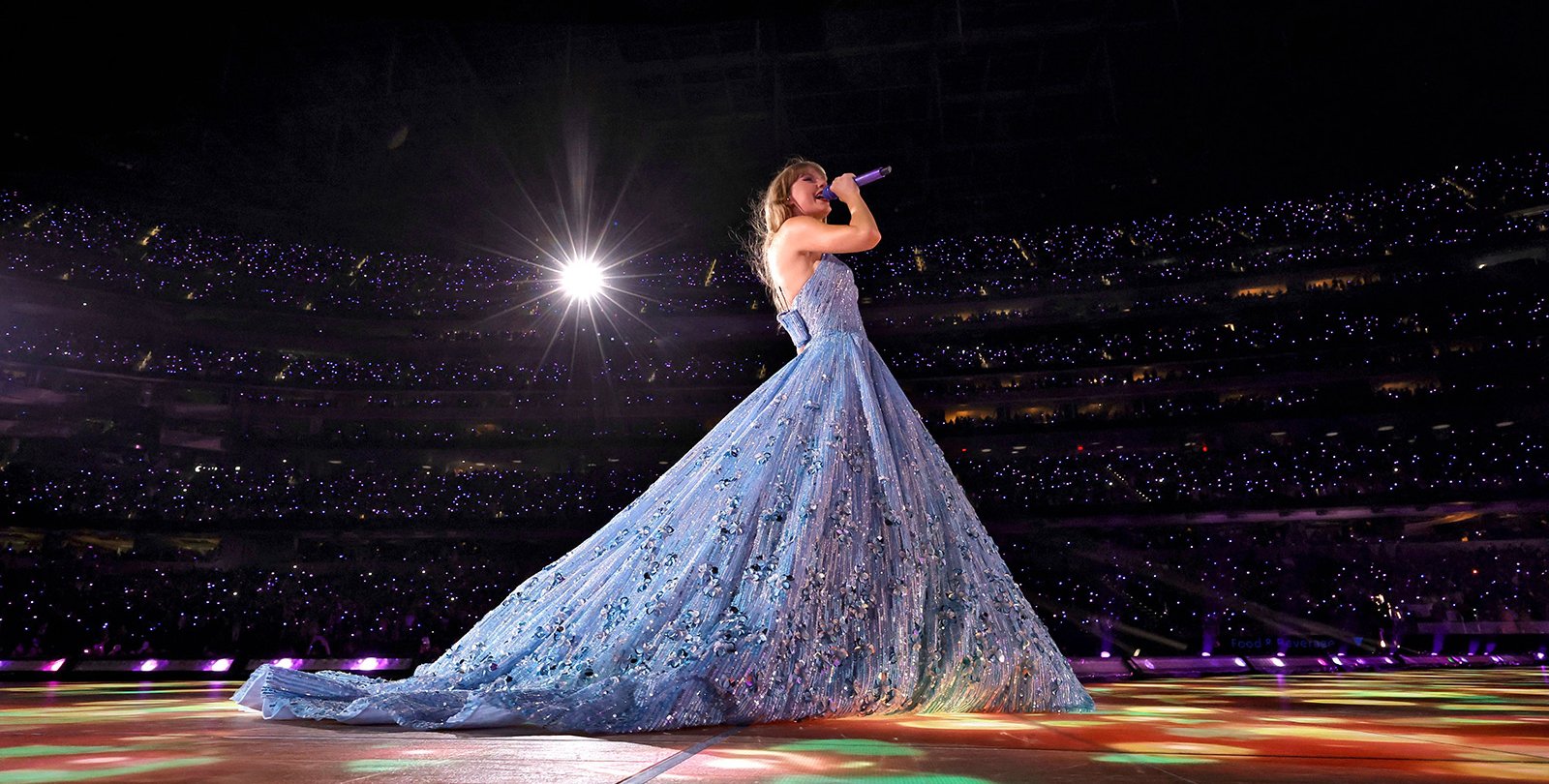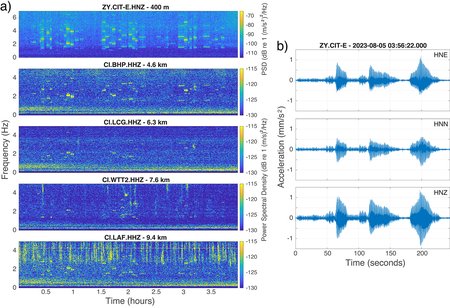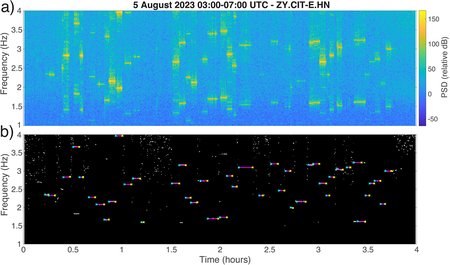
Swifties "Shake It Off" and Help Seismologists Solve Mystery of How Concertgoers Shake Things Up
Fans at Taylor Swift's Eras Tour concerts in Los Angeles made SoFi Stadium and the ground around it "ring like a bell" last August, creating measurable seismic activity during each song. So say scientists from Caltech and UCLA, who collected seismic data during one of the shows.
In a new paper, the researchers report that it was the dancing and jumping movements of the 70,000-plus fans, not the music or sound system, at the August 4 concert that created the seismic waves that have come to be called "Swift quakes."
Following reports of seismic tremors generated by fans at sporting events and a Taylor Swift concert in Washington state, the California Office of Emergency Services reached out to seismic network operators in California to see if any interesting data could be collected during Swift's concerts at SoFi Stadium, August 3–9.
Monica Kohler (PhD '95), research professor of mechanical and civil engineering at Caltech, and her colleagues responded. To study Swift's show on August 4, they tapped into an existing regional network of seismic stations, gathering data from permanent sensors reaching as far as about 6 miles from the stadium. They also temporarily installed 10 seismic sensors within SoFi itself and one more across the street. The sensors installed inside the stadium were inexpensive accelerometers that the researchers regularly build and deploy using off-the-shelf parts for the Community Seismic Network, a distributed network of more than 1,200 strong-motion detectors in California.
The researchers were not disappointed. The stadium and its surroundings certainly shook during the show. As expected, the manner of shaking was less like an earthquake, with a clear spike in ground movement, and more like harmonic tremor that involves bursts of energy at specific frequency intervals over longer periods of time. This type of seismicity is often associated with volcanic activity, such as the underground movement of magma.
Gabrielle Tepp, staff seismologist at Caltech's Seismological Laboratory and lead author on the new paper, likens the difference between an earthquake and harmonic tremor to that between an explosion and the roar of a jet engine. "One is very sharp and very short, while the other may not be as loud at its peak but lasts for a longer time," Tepp says.
To analyze the results, the researchers turned to spectrograms, graphs showing how much energy is measured at various frequencies of vibration over time. By pulling out the seismic signals from the spectrograms, the scientists were able to identify 43 out of the 45 songs Swift played at her concert and calculated the total amount of energy radiated for each. They found that the song that came with the largest "concert tremor" was "Shake It Off." During that song, the amount of radiated energy was equivalent to an earthquake of magnitude 0.85. "But remember that is the total amount of energy over the duration of a song," Tepp cautions. "If you look at the maximum amplitude, just for one moment, that was more like a minus-2 magnitude event."
Kohler notes that the data recorded inside the stadium looked very similar to those that were recorded by sensors outside the stadium, even at such a distant and busy location as Los Angeles International Airport. "The very active humans at the Taylor Swift concert were causing the stadium to ring like a bell at different frequencies," she says. "And that energy propagated through the ground to all these other sites where we recorded vibrations. This is a reminder that we need to understand all of the different pieces of this big interconnected system."
Until now, seismologists have disagreed about what exactly was causing the seismicity related to concert tremors. Some claimed it was the vibrating loudspeakers or the instruments coupled to the stage that caused the shaking while others said it was more likely to be the movements of all the concertgoers.
The data showed that the movement, not the music, best fit the waveforms. To confirm that answer, Tepp, herself a bass guitarist, conducted a simple experiment. She set up a portable PA system close to one of the team's accelerometers and blasted Swift's song "Love Story." Near the end, she jumped up and down to the beat. It was only when she started jumping that the seismic sensor recorded harmonic signals. Tepp also tried playing her bass guitar to a steady beat with the same speaker and, again, did not find the nice harmonic signal even though, as she says, "the bass beats were probably more exactly on the beat than my jumping was."
The study was not only about investigating the source of concert tremor. Kohler points out that during emergencies, stadiums and other large structures, such as conference centers, are used as emergency shelters. "In those cases, it would be really important to be able to monitor the motions of these structures before, during, and after a large-scale event like an earthquake to be able to determine whether the structure is still safe, reliable, and sound," Kohler says. "That was one of the motivations for our deployment of sensors inside SoFi Stadium: to see if this new seismic network that we have developed could be used in ongoing monitoring of structural motions."
And indeed, the study showed that the inexpensive accelerometers used by the Community Seismic Network are capable of measuring fairly small vibrations within a stadium and relaying those measurements in real-time to scientists.
Tepp points out that the study also serves as a useful reminder that earthquakes are not the only kind of seismic activity that seismologists should be analyzing. "We've designed all of our magnitude scales based on earthquakes, but what do you do when the signal doesn't look like an earthquake? How do you characterize its strength?" Tepp says. "Looking at these non-earthquake signals can be really helpful for evaluating the different tools that we have as seismologists and reevaluating our assumptions that go into those."
The same holds true for civil engineering, Kohler says. "We want to use earthquake and non-earthquake sources of vibration to identify how structures move," she says. "We need that baseline response—to know how the structure is responding during times of good health—to know then how those responses might have changed after some large shaking event."
The new paper, titled "Shake to the Beat: Exploring the Seismic Signals and Stadium Response of Concerts and Music Fans" appears online in the journal Seismological Research Letters. Additional co-authors on the work are Igor Stubailo of Caltech's Seismological Laboratory and Richard Guy and Yousef Bozorgnia of UCLA. The Southern California Seismic Network is funded by the U.S. Geological Survey and the California Office of Emergency Services. The Community Seismic Network is funded by California Geological Survey, the Conrad N. Hilton Foundation, the Terrestrial Hazard Observation Reporting (THOR) Center at Caltech, and the Divisions of Geological and Planetary Science and Engineering and Applied Science at Caltech. The Southern California Earthquake Data Center is funded by the National Science Foundation and the U.S. Geological Survey.
 Spectrograms (a) showing recordings of Swift's August 4 concert gathered at five seismic stations at different distances from SoFi Stadium. Color here indicates how much energy was detected at different frequencies over time. The plots to the right (b) show an example of waveforms associated with concert tremor. Ground shaking during the song "Love Story" is plotted over time. There are three waveforms corresponding to each of three components measured by strong-motion sensors—one vertical component that measures up and down particle motion, and two horizontal components that are perpendicular and aligned east-west and north-south. Seismologists need all three components to determine the orientation of a seismic wave.
Spectrograms (a) showing recordings of Swift's August 4 concert gathered at five seismic stations at different distances from SoFi Stadium. Color here indicates how much energy was detected at different frequencies over time. The plots to the right (b) show an example of waveforms associated with concert tremor. Ground shaking during the song "Love Story" is plotted over time. There are three waveforms corresponding to each of three components measured by strong-motion sensors—one vertical component that measures up and down particle motion, and two horizontal components that are perpendicular and aligned east-west and north-south. Seismologists need all three components to determine the orientation of a seismic wave.
 The researchers were able to identify seismic signals related to 43 of the 45 songs Swift played during her August 4 concert. Each magenta line shown in (b) represents shaking during a single song. The original spectrogram (a) showing the energy at a particular frequency over time is shown above.
The researchers were able to identify seismic signals related to 43 of the 45 songs Swift played during her August 4 concert. Each magenta line shown in (b) represents shaking during a single song. The original spectrogram (a) showing the energy at a particular frequency over time is shown above.
